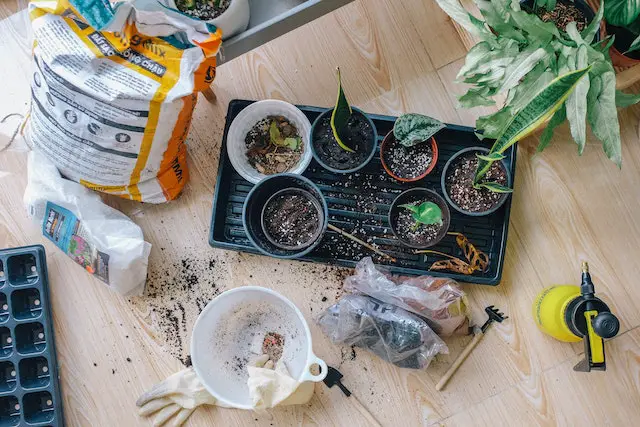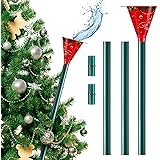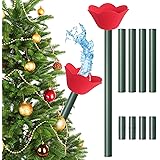If you’re new to gardening, you may be confused about the purpose of a propagator or wonder whether you need one at all. Here’s what you need to know about propagators, when to use them, and what your options are if you decide that a propagator isn’t right for your garden space.
If you’re an experienced gardener who wants to know the best way to care for plants inside your propagator, check out our guide to using your new gardening tool.
What is a propagator?
A propagator is a small, enclosed space where you can control the environment to encourage seed germination and growth.
If you’re moving seedlings from a propagator, open the vents, so they can acclimate to their new surroundings.
When to remove seedlings from a propagator depends on the plant and how big it is. If you’re using a homemade propagator, make sure it gets plenty of sunlight. Seed propagators are great for starting plants from seed.
Plants grown in them often take less time to mature than those grown outside because they’re sheltered from harsh conditions like cold, wind, or rain.
They also produce healthier and more vigorous seedlings with more root hairs, which makes them better able to withstand transplanting into the garden once they’re ready to go outside.
What are they used for?
Plant propagators are used to create the ideal environment for seed germination and cuttings.
They help to regulate temperature, humidity, and ventilation. When to open vents on a propagator will depend on the plant type and the current weather conditions. For example, if you have a warm humid day in winter then you may want to close your vent so that the air doesn’t dry out your seedlings too quickly.
You should also keep an eye on your plants as they can often look like they need water when in fact they need more heat or less light.
The best way to tell is by looking at the roots. If they start curling up, it means that it is time to move them into a larger pot with soil and place them under brighter lights. And finally, be sure not to overwater!
How much do they cost, and where can you buy them?
You may be wondering how to use a propagator or what does a plant propagator do. Plant propagators are devices used to create the optimal environment for seed germination and plant growth. They can be used to control temperature, humidity, and light exposure.
Most home and gardening stores sell propagators of various sizes and specifications, but some smaller stores may not carry them. You can also find them online if you don’t have any nearby options.
On average, they cost between $20 and $50, depending on size and features.
The most common sizes are about 2 feet by 2 feet and 5 inches deep. The variety of features is vast so it is important to know what your needs are before purchasing one.
If you only need to house a few plants, then a small tabletop model will work well for you. But if you plan on housing many plants in it at once, then opt for a larger unit with more shelves and heaters.
Can you make your own, and how much would it cost?
You can make your own propagator for a fraction of the cost of buying one. All you need is a clear plastic container, some perlite, and some water.
Drill or poke holes in the bottom of the container for drainage, then fill it with perlite. Wet the perlite and add your plants. Place the lid on the container and set it in a sunny spot. Water as needed to keep the perlite moist.
The plant roots will grow down into the wetted perlite, which helps them grow faster. The light from above will help get more sunlight onto the leaves and promote photosynthesis.
There are also other types of propagators that work differently: solar (it needs direct sunlight), cold frame (it has an opening at top), heated propagator (you’ll have to provide electricity).
Things to consider before buying one
If you’re starting your garden from seed, you might be wondering if you require a propagator. There are a few things to consider before making the purchase.
First, think about the size of your garden. If you have a large space, you might not need a propagator.
Second, consider the climate you live in. If it’s warm year-round, you might not need one.
Third, take into account the amount of time and effort you want to put into your garden. If you love gardening but don’t have a lot of time to spend on it, then a propagator is probably right for you.
The last thing to consider is whether or not you’ll be growing plants that require lots of warmth like tomatoes and peppers. In this case, having access to an enclosed space will help those plants grow better. It can also help if your winter gets cold enough that the inside temperature dips below 60 degrees Fahrenheit during the day because plants stop growing when they get too cold.
Having a place to keep them warmer could mean the difference between small plants and large, healthy ones. For these reasons, some people find that having a propagator has been well worth the cost.
 .
.Where can you find more information about the best ones to buy?
You can find more information about propagators online, through gardening magazines, or by talking to other gardeners.
Some things to consider when choosing a propagator include the size of the unit, the type of material it is made from, and how many plants you want to be able to grow at one time.
For example, if you have limited space in your home, then a table-top model might be a better choice than a floor-standing model.
Additionally, think about what kind of materials are most important to you. Will they be heavy enough to hold up in outdoor conditions?
Can they withstand cold temperatures or windy conditions?
Will they stand up on their own or will they need to be propped up against something else?
How many units do you want to be able to use at once?
Is this just for inside growing or do you plan on using it outside as well?
How much do you want to spend?
All these factors should go into deciding which propagator is best for your needs.
Where can you find more information about growing plants from seed in general?
You can find more information about growing plants from seed in general by looking online, visiting your local library, or speaking to experienced gardeners.
There are also many helpful books available on the subject. Some of the most important things to consider when growing plants from seed are the type of soil you use, the amount of sunlight and water the seeds will need, and whether you will need to use a heat mat.
Plants grown from seed need approximately eight hours of light per day. If you plan to grow them indoors, be sure that they are close enough to a window that receives at least six hours of sunlight each day. If they don’t receive enough light, they may fail to thrive or stop developing altogether.
Plants grown outdoors should be planted near windows with sun exposure or under artificial lights for 8-12 hours per day.
For indoors, there are often two ways to provide sufficient light. Placing pots closer to an outside window or using an indoor grow light such as CFLs (compact fluorescent lights) or LEDs (light emitting diodes). These types of lights can be purchased at any home improvement store. It is best to start with one set of LED bulbs and see how the plants respond before purchasing additional sets. These bulbs can last up to 15 years!
Frequently asked questions (FAQs)
Should a propagator have condensation?
No, you don’t always need to worry about condensation with your propagator. All you need to focus on is ensuring that your propagator is in place and ready for use.
Should I water seeds during germination?
Yes, it’s important to keep the soil moist but not saturated or else it will be difficult for the seedlings to break through.
What temperature should my propagator be set at?
Different plants require different temperatures, so it really depends on what type of plant you are trying to grow from seed. You may find that certain types of plants work better with cooler temps, while others work better with warmer temps. The best way to see how well your plant does at certain temperatures is by researching their preferred temps ahead of time.
Should I be checking moisture levels?
Yes, always check your propagator every day to make sure there isn’t too much moisture in the soil and there is enough air circulating around the roots.
Wrapping it up
Still, wondering about getting a propagator? If you’re serious about starting a garden, then you’ll need to invest in a propagator. A propagator is essential for giving your plants the best chance of survival and ensuring that they thrive.
There are many types of propagators available on the market, so it’s important to do your research to find the one that best suits your needs. With a bit of care and attention, your propagator will help you create a beautiful garden that you can enjoy for years to come.
Auto Amazon Links: No products found.
Perfect Plants Christmas Tree Saver 8oz. | Easy Use Xmas Tree Preserver Food | Have Healthy Green Christmas Trees All Holiday Season
$9.97 (as of December 13, 2025 05:07 GMT +00:00 - More info- Product prices and availability are accurate as of the date/time indicated and are subject to change. Any price and availability information displayed on [relevant Amazon Site(s), as applicable] at the time of purchase will apply to the purchase of this product.
Rocky Mountain Goods Christmas Tree Food - 8 oz Tree Preservative - Reduce Needle Drop - Greener Scent - Fir, Pine, Spruce Trees - Extend Tree Life
$9.95 (as of December 13, 2025 05:07 GMT +00:00 - More info- Product prices and availability are accurate as of the date/time indicated and are subject to change. Any price and availability information displayed on [relevant Amazon Site(s), as applicable] at the time of purchase will apply to the purchase of this product.
FirEver Pure Christmas Tree Food | Preserver Additive & Season Extender for Live Xmas Trees | Keep It Green, Reduce Needle-Drop | Miracle Freshness (8 oz)
$14.99 (as of December 13, 2025 05:07 GMT +00:00 - More info- Product prices and availability are accurate as of the date/time indicated and are subject to change. Any price and availability information displayed on [relevant Amazon Site(s), as applicable] at the time of purchase will apply to the purchase of this product.
VICAMB 39.3 Inch Christmas Tree Watering Funnel,Christmas Tree Watering System Device,Long Tree Watering Funnel Spout for Indoor Outdoor Xmas Tree
$16.99 (as of December 13, 2025 05:07 GMT +00:00 - More info- Product prices and availability are accurate as of the date/time indicated and are subject to change. Any price and availability information displayed on [relevant Amazon Site(s), as applicable] at the time of purchase will apply to the purchase of this product.
EZMeetU Christmas Tree Watering Funnel, 47 Inch Flower Shape Adjustable 6 Section Design, Christmas Tree Watering System, Christmas Tree Waterer, Long Funnel Wide Opening Reusable, Plant Watering Tool
$16.99 (as of December 13, 2025 05:07 GMT +00:00 - More info- Product prices and availability are accurate as of the date/time indicated and are subject to change. Any price and availability information displayed on [relevant Amazon Site(s), as applicable] at the time of purchase will apply to the purchase of this product.
Snow Joe Premium Enviro Blend Ice Melt, Green-Coated Deicer Crystals, 50 lb - Safer Melter for Vegetation, Concrete & Metals w/ Anti-Corrosion Calcium Magnesium Acetate
$32.97 (as of December 12, 2025 19:27 GMT +00:00 - More info- Product prices and availability are accurate as of the date/time indicated and are subject to change. Any price and availability information displayed on [relevant Amazon Site(s), as applicable] at the time of purchase will apply to the purchase of this product.
Muddy Mat® Shown on TV Super Absorbent Microfiber Dog Door Mat for Muddy Paws, Non-Slip Washable Pet Rug, Quick Dry Chenille Entryway Carpet, Machine Washable Indoor Outdoor mat, Grey 30"x19"
$24.95 (as of December 12, 2025 19:27 GMT +00:00 - More info- Product prices and availability are accurate as of the date/time indicated and are subject to change. Any price and availability information displayed on [relevant Amazon Site(s), as applicable] at the time of purchase will apply to the purchase of this product.
ivtivfu Rolling Grill Basket, Removable Wooden Handle, 304 Stainless Steel, Nesting BBQ Tools, Smoker Grilling Accessories for Vegetable, Outdoor Cooking Camping, Birthday Gifts for Men Dad Husband
$25.99 (as of December 12, 2025 19:27 GMT +00:00 - More info- Product prices and availability are accurate as of the date/time indicated and are subject to change. Any price and availability information displayed on [relevant Amazon Site(s), as applicable] at the time of purchase will apply to the purchase of this product.
XXXFLOWER Plant Terrarium with Wooden Stand, Air Planter Bulb Glass Vase Metal Swivel Holder Retro Tabletop for Hydroponics Home Garden Office Decoration - 3 Bulb Vase
$18.98 (as of December 12, 2025 19:27 GMT +00:00 - More info- Product prices and availability are accurate as of the date/time indicated and are subject to change. Any price and availability information displayed on [relevant Amazon Site(s), as applicable] at the time of purchase will apply to the purchase of this product.
Zevo Flying Insect Trap Official Refill Cartridges - Fits Both Zevo Trap & MAX Indoor Fly Trap - Authentic Trap+Lock Technology to Catch Gnats, House & Fruit Flys (4 Official Refill Cartridges)
$14.97 (as of December 12, 2025 19:27 GMT +00:00 - More info- Product prices and availability are accurate as of the date/time indicated and are subject to change. Any price and availability information displayed on [relevant Amazon Site(s), as applicable] at the time of purchase will apply to the purchase of this product.



















